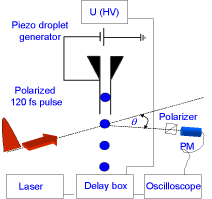Cawses_Seite_2
SHG by a surface of charged water microdroplet
Second Harmonic Generation (SHG) is a versatile probe of physical and chemical parameters of many interfaces. It has been used for characterization of molecular adsorption on polymer beads, clay particles, emulsions and sprays or even biological particles. SHG has been employed to observe molecular transport across living cell membranes as well to determine their surface potential. It has also been demonstrated to probe the surface potential of planar water-air interfaces.
The possibility of using the SHG for detection of electrically charged cloud or aerosol particles was for the first time proposed by V. Boutou et al.. However, no quantitative measurements have ever been performed to prove its suitability for this purpose as well as atmospheric applications. It is, therefore, reasonable to continue experimental work on this interesting subject to address in the first line a fundamental question on cross-sections of microdroplets induced SHG.
Laboratory experiments

Fig. 1 Experimental setup.
First we plan to experiment with free falling water microdroplets generated by a piezoelectric injector. Droplets diameter will be varied between single micrometers up to a hundred of micrometers to simulate actual cloud particles. Each droplet will be charged by high voltage (HV) applied to the generator nozzle. A number of elementary charges on their surface will be effected by variable amplitude of HV, allowing simulations of different cloud types (e.g. the droplets of thunderstorm clouds have ~104-105 elementary charges on them, while non-thunderstorm clouds only ~102). Each falling droplets will be next illuminated by fs-laser pulse. The Second Harmonic (SH) emission will be characterized by its dependence on scattering angle and polarization of emitted light. Envisioned experimental setup is schematically depicted in Fig. 1.
We expect to determine the efficiency of radiation conversion for the SHG (SHG cross-sections). It seems reasonable to expect that this efficiency strongly depends on applied surface charge. It is still unclear if the proposed method will be suitable for detection weakly electrified particles in convective clouds. Another interesting issue is the angular distribution of second harmonic (SH) signal. For LIDAR applications the backward emission would be favorable, but the optimal geometry of the LIDAR measurement is still an open question.
Lidar experiments

Fig. 4 Schematic representation of the lidar setup for cloud
charge measurements.
In the second phase we want to detect SH emission from clouds and atmospheric aerosols. A fs-laser pulse will be sent in the atmosphere and subsequent LIDAR signal will be recorded. The pulse will be negatively (opposite to GVD) chirped in order to pre-compensate dispersion. In this way the maximum of pulse intensity will be localized directly in the cloud. Both SH and elastic scattering signals from clouds can be measured to obtain information on droplets' charge but also other parameters like optical thicknes or size distribution.
The setup for intended LIDAR measurements is depicted in Figure 4. It is based on the laser system delivering either 100 fs pulses of 1 mJ energy at 1 kHz rep. rate or 50 mJ pulses of the same duration at 10 Hz.
The detection unit consist of a 40 cm Newtonian telescope, a photon counting suitable photomultiplier, a fast transient recorder and a photon counter. Alternatively we can use a 250 mm Czerny-Turner spectrometer with sensitive iCCD camera.
weiter-->